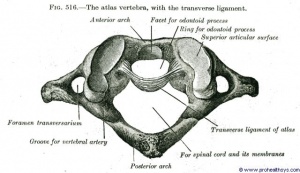Transverse Ligament Stress Test: Difference between revisions
Anas Mohamed (talk | contribs) No edit summary |
(typo errors corrected, added links to PP and added evidence) |
||
| Line 8: | Line 8: | ||
Test for hypermobility of the [https://physio-pedia.com/Atlanto-axial_joint?utm_source=physiopedia&utm_medium=search&utm_campaign=ongoing_internal#share atlantoaxial] articulation | Test for hypermobility of the [https://physio-pedia.com/Atlanto-axial_joint?utm_source=physiopedia&utm_medium=search&utm_campaign=ongoing_internal#share atlantoaxial] articulation | ||
== Technique | == Technique == | ||
[[Image:Gray516.jpg|thumb]] | [[Image:Gray516.jpg|thumb]] | ||
*The patient is placed in a supine | *The patient is placed in a supine position with the Therapist supporting the patient's head with the palms and 3rd-5th fingers.<ref name=":0">↑ Dutton, M. (2008). Orthopaedic: Examination, evaluation, and intervention (2nd ed.). New York: The McGraw-Hill Companies, Inc.</ref> | ||
*The Therapist then places the index fingers between the occiput and spinous process of C2, so the index fingers are over the neural arch of the C1 | *The Therapist then places the index fingers between the occiput and spinous process of [[Cervical Anatomy|C2]], so the index fingers are over the neural arch of the C1 vertebra.<ref name=":0" /> | ||
*The Therapist then lifts the | *The Therapist then lifts the patient's head and C1 vertebra anteriorly, without allowing flexion or extension. | ||
*The position should be held for 10-20 seconds. | *The position should be held for 10-20 seconds.<ref name=":0" /> | ||
*A positive test is the recurrence of symptoms: | *A positive test is the recurrence of symptoms<ref name=":0" />: | ||
*#Abnormal pupil response | *#Abnormal pupil response | ||
*#Eye twitching or nystagmus | *#Eye twitching or nystagmus | ||
*#Soft end feel | *#Soft end-feel | ||
*#Muscle spasm | *#Muscle spasm | ||
*#Dizziness | *#Dizziness | ||
| Line 32: | Line 32: | ||
== Evidence == | == Evidence == | ||
According to the study by Hutting N et al., the specificity of the test is sufficient, which means the test can be used to ''rule in'' patients with upper cervical spine instability however it has low Sensitivity which means it is insufficient for detecting upper cervical spine instability. A study by Kaale et al. (2008) shows the Transverse Ligament Stress test has a diagnostic accuracy of sensitivity 65%, the specificity of 99%, predictive values 0.97, and positive likelihood ratios of 51.44 and negative likelihood ratio of 0.35. The predictive value and positive likelihood ratios of the transverse ligament test were found to be sufficient<ref>Hutting N, Scholten-Peeters GG, Vijverman V, Keesenberg MD, Verhagen AP. [https://academic.oup.com/ptj/article/93/12/1686/2735395 Diagnostic accuracy of upper cervical spine instability tests: a systematic review.] Physical therapy. 2013 Dec 1;93(12):1686-95.</ref>. | |||
== Resources == | == Resources == | ||
Revision as of 22:35, 21 September 2020
Original Editor - Tamara Eller and Audrey Pittman
Top Contributors - Tamara Eller, Audrey Pittman, Admin, Vidya Acharya, Rachael Lowe, Kim Jackson, Evan Thomas, Anas Mohamed, Tony Lowe, Kai A. Sigel and WikiSysop
Purpose[edit | edit source]
Test for hypermobility of the atlantoaxial articulation
Technique[edit | edit source]
- The patient is placed in a supine position with the Therapist supporting the patient's head with the palms and 3rd-5th fingers.[1]
- The Therapist then places the index fingers between the occiput and spinous process of C2, so the index fingers are over the neural arch of the C1 vertebra.[1]
- The Therapist then lifts the patient's head and C1 vertebra anteriorly, without allowing flexion or extension.
- The position should be held for 10-20 seconds.[1]
- A positive test is the recurrence of symptoms[1]:
- Abnormal pupil response
- Eye twitching or nystagmus
- Soft end-feel
- Muscle spasm
- Dizziness
- Nausea
- Paresthesia of the lip face or limb
- Lump sensation in the throat
Evidence[edit | edit source]
According to the study by Hutting N et al., the specificity of the test is sufficient, which means the test can be used to rule in patients with upper cervical spine instability however it has low Sensitivity which means it is insufficient for detecting upper cervical spine instability. A study by Kaale et al. (2008) shows the Transverse Ligament Stress test has a diagnostic accuracy of sensitivity 65%, the specificity of 99%, predictive values 0.97, and positive likelihood ratios of 51.44 and negative likelihood ratio of 0.35. The predictive value and positive likelihood ratios of the transverse ligament test were found to be sufficient[2].
Resources[edit | edit source]
Pettman E: Stress tests of the craniovertebral joints. In: Boyling, JD, Palastanga N, eds. Grieve's Modern Manual Therapy: The Vertebral Column, 2nd edn. Edinburgh: Churchill Lingstone, 1994:529-538.
References[edit | edit source]
- ↑ 1.0 1.1 1.2 1.3 ↑ Dutton, M. (2008). Orthopaedic: Examination, evaluation, and intervention (2nd ed.). New York: The McGraw-Hill Companies, Inc.
- ↑ Hutting N, Scholten-Peeters GG, Vijverman V, Keesenberg MD, Verhagen AP. Diagnostic accuracy of upper cervical spine instability tests: a systematic review. Physical therapy. 2013 Dec 1;93(12):1686-95.







